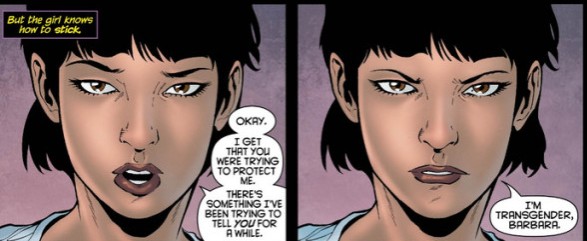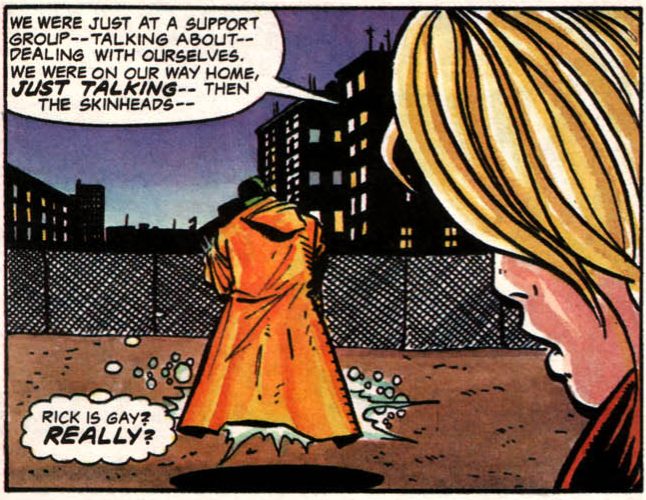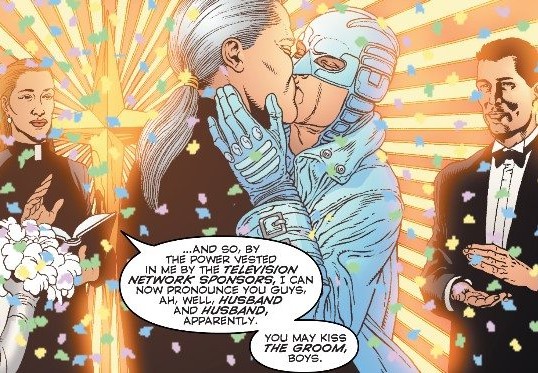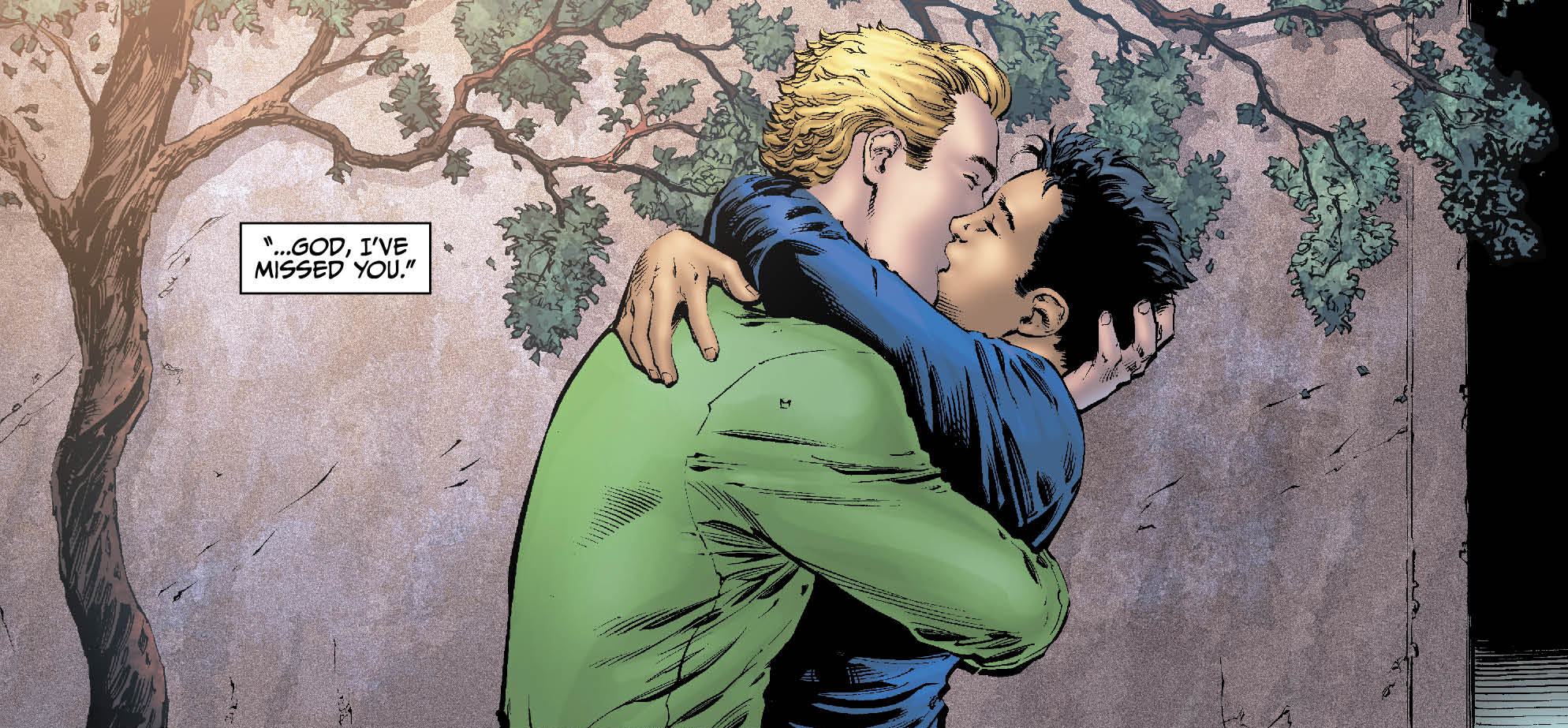Pride Month may be coming to a close, but recognition for LGBTQ+ characters is still going strong. Welcome to part two of DCN’s Pride Month Celebration! In this list, we’ll cover five more of the LGBTQ+ DC characters that have made history, connected with fans, and expanded the horizons of representation in the world of superheroes. If you’re just checking out the lineup, be sure to read part one for more on the complex story of DC’s history with characters of different sexual orientations and gender identities. I would like to reiterate that even though some of these depictions are flawed, they represent important moments of change in the comic book world. That being said, I have chosen not to include any fully problematic representations in the interest of saving space for characters that have elevated the LGBTQ+ community.
Poison Ivy and Harley Quinn

From convention floors to Hot Topic, Harley and Ivy are two of the most recognizable faces in comics. Harley may be best known for her tumultuous relationship with Joker, but continuity turned away from that trainwreck long ago. Though she started out as a side character on Batman: the Animated Series, Harley Quinn has found a life of her own; one that has quickly seen her popularity rise to rival that of Mista J himself. Her transformation from groveling sidekick to pop culture icon is dazzling, and though fighting for her own agency has a lot to do with that, Harley wouldn’t be the clown queen we know and love without her true life-partner, Poison Ivy.
Ivy and Harley were first paired up during BTAS. Sure, the show never outright claimed a relationship between them, but the signs were about as subtle as a bat to the face. When Harley finds herself on the outs with Joker, Ivy is there to get her back on her feet with positive affirmation, girl power, and explosives. Even with all of the flash and sparkle, it’s hard to miss that Ivy and Harley seem especially close- lounging around the house together in underwear close. There’s nothing inherently sexual about being your most comfortable self around your pals, but what makes this choice notable is the fact that they are the only pair in the show to do so. It creates a subtext that does not exist between any other BTAS characters. This detail can be read as more of an objectifying fantasy fulfillment and than a genuine representation of a lesbian romance, but the impression it left on viewers can’t be overstated. Whatever the reasoning, the way Harley and Ivy were depicted on screen planted a seed, one that I picked up on even as a kid. Joker is terrible to Harley, Ivy isn’t. Joker doesn’t appreciate Harley, Ivy does. Joker’s not a good match for Harley, but Ivy…
In the years since the show, Harley and Ivy’s romantic partnership has become public knowledge. Whenever they appear together, they radiate love and mutual support, even though their relationship status tends to fluctuate. Perhaps that is the most beautiful thing about Harley and Ivy. They love each other unconditionally, even when changing story arcs and supervillain obligations mean they have to put the romance aside for a while. They always find their way back to each other sooner or later. In 2019, DC Universe’s Harley Quinn animated series took their story to the next level. Finally, fans have been able to watch Harley and Ivy’s feelings for each other evolve in all of their adorable chaotic glory. It’s hard to say whether or not the pair will make it last long term this time, but considering their history, we’ll never have to worry about them being apart for long.
Alysia Yeoh

In the New 52’s Batgirl by Gail Simone, readers followed Barbara Gordon’s recovery journey as she coped with the lasting effects of being shot by the Joker. When Barbara felt like there was no one she could confide in, she found an unexpected ally in her roommate, Alysia Yeoh. Alysia initially came across as stand-offish and blunt, but as she and Barbara’s friendship developed, the fiercely loyal, self-reliant Alysia underneath came to the surface.
Turns out, she had a very good reason for keeping her new roommate at an arm’s length (besides Barbara’s tendency to come home injured and covered in blood). Alysia is a transgender woman, a fact that sheds new light on the walls she places between herself and strangers. Alysia lives with a heightened awareness in order to keep herself safe. Only when she’s certain she knows Barbara does she feel comfortable letting her guard down and opening up to the person sharing her living space. Alysia holds her privacy close, which ironically makes her a perfect roommate for a struggling vigilante.

The New 52 didn’t go much deeper into Alysia’s story, but when Batgirl took the leap over to Burnside and eventually into Rebirth, Alysia came along. Writers have developed Alysia past her “mysterious roommate” persona, depicting her in recent titles as Barbara’s best friend. Additionally, her storyline has started to carry more weight in DC continuity. In fact, in Batgirl #45 (2015) Alysia’s wedding to her partner, Jo, became the first transgender wedding in mainstream comics. Alysia has gone on to be featured in DC Bombshells (2016) and DC Bombshells: United, in which she is a member of a young vigilante crew known as The Batgirls. By all indications, Alysia Yeoh’s destiny in the DC universe is just beginning.
Rick Stone

Who is Rick Stone? Well, if you were a fan of the animated show Static Shock, you know him. In the animated universe, he went by Richie, Static/Virgil’s best friend. In the show, Static and Richie worked through tough real-world issues together and always came out stronger for it. Sadly, that wasn’t the case in the comics. Static was created in the Dakotaverse of Milestone comics, an offshoot of DC that championed black creators and characters in an otherwise non-inclusive medium. Milestone was known for bringing underrepresented voices to the table and pushing the creative envelope. They not only sought to make a space for black stories, but wanted to open the floor to all peoples of color, as well as the LGBTQ+ community.
Static #16 (1994) stood true to this idea and depicted a heartbreaking reality for queer youth. In this issue, Virgil’s good friend, Rick, tries to help an injured young man and consequently reveals that both of them are part of a support group for gay youth. If you’re waiting for Virgil to be a hero in this story, don’t hold your breath. Virgil reacts with confusion and anger. Following the series from the beginning, this isn’t surprising. From the first issue, a still closeted Rick is berated by a classmate with an onslaught of homophobic jokes. These jokes follow him throughout the first sixteen issues, during which Virgil does nothing to defend his friend. When Rick eventually admits that he is gay, Virgil becomes frustrated with the gossip that follows. He expresses to Rick that he wishes he’d just stayed in the closet so things could be normal and is openly displeased by Rick’s choice to stand by who he is.

Why did I choose to include such a devastating story on this list? Firstly because, as Richie, many of us are familiar with this character without any knowledge of his backstory. Secondly, in 1994, narratives like this were all but absent from mainstream comics. Though the story is tragic and disappointing, it was meant to showcase the complexities of life for people from all different backgrounds. Static’s shameful reaction and Rick’s resolve to be true to himself opened up a discourse between fans. Whether readers related more to Virgil or Rick, Static #16 was a push to consider whether or not our day to day actions are heroic. Rick sticks to his truth. He tries to help someone in need regardless of how the effort will damage his personal life. His superhero best friend, on the other hand, behaves with frigid selfishness. With a relaunch of Milestone reportedly on the way, maybe we’ll get to see a new, more hopeful chapter of Rick’s life.
Apollo and Midnighter

Would you take an Orpheus style journey into Hell for your true love? Midnighter would. First appearing in Wildstorm’s Stormwatch, Apollo and Midnighter could be seen as Superman/Batman archetypes with a satirical twist. DC eventually obtained the pair when they took over Wildstorm, but that never slowed down the romance between these two heroes. Many comic fans recognize Apollo and Midnighter as being the first openly gay couple to be married in comics. Their 2002 nuptials were a leap forward for LGBTQ+ representation in comics, however, that doesn’t mean that their relationship has always been a beacon of hope.
Many readers agree that the positivity of Apollo and Midnighter’s relationship comes down to who writes them in any given arc. In their original Warren Ellis incarnation, their attraction is almost immediately evident. While the actual romances of gay characters in previous comics rarely made it onto the page, Apollo and Midnighter’s connection is built up from the start, allowing readers to see their feelings develop and play out over multiple issues. Though they have always been written as gay characters, the tone of their adventures and marital status has fluctuated throughout the years. The pair has broken up, gotten back together, and everything in between.
Also noteworthy is the lens through which we see Apollo and Midnighter. Their wedding in The Authority #29 is largely framed through the eyes of heterosexual characters. We even see a man gag at the sight of them kissing, which is strangely included while depictions of them having fun at their own wedding are not. Even so, this superhero relationship broke a barrier that was barely approached before their time. Showing a homosexual couple in an intimate light simply hadn’t been done in comics before Apollo and Midnighter. Despite the problematic aspects of their history, their relationship did mark a new chapter in comics; one in which gay characters behaved romantically on the page, not just by implication.
Alan Scott (Green Lantern, Earth 2)

Earth 2 Alan Scott is one of the more controversial LGBTQ+ depictions in the DC universe. This is mainly due to the fact that the original Alan Scott, the first Green Lantern, was not written as gay when he first appeared in 1940. The character was reintroduced on Earth 2 in 2012 as an openly gay media mogul. Though characters like Batwoman and Aqualad have undergone serious changes to their continuity and sexual preference in recent decades too, the reveal that Alan Scott was gay felt a little performative to some fans.
The announcement that a major DC character was going to be revealed as gay came first, which made the follow-up confirmation that it was Alan Scott feel just a tad strange. After all, current continuity already had a Green Lantern. Alan Scott was, in a sense, irrelevant. For many of us, the golden age Green Lantern felt like a choice just important enough to make waves, but not quite important enough to impact any of DC’s big selling characters or books. The overall feeling seemed to be “…okay…”. For all the pomp and circumstance, the announcement didn’t seem to have much payoff.
Even so, Earth 2 Alan Scott’s storyline was decently written. A media mogul faces the tragic loss of his boyfriend and fuses the power of the Green Lantern into the ring he intended to propose to his late love with; it has all of the tragedy and science fiction a good superhero origin needs. Furthermore, because of the immense publicity the relaunch got, most comic fans are aware of this version of Alan Scott, making him especially visible.
And it seems as if DC may be bringing this back into the current continuity, as shown in the recently released Green Lantern 80th Anniversary 100-Page Super Spectacular.
As comics become a more inclusive medium, we can only hope that someday there will be far too many examples of well written LGBTQ+ characters to list. It certainly seems that we are heading down a better path than ever before. Of course, that doesn’t mean that there isn’t still a lot of work to be done to create fair and consistent representation of LGBTQ+ stories in comics. Do you have any favorite stories of the characters listed above? Are there any characters you think we should have included in the spotlight? Let us know in the comments below, and once again, happy Pride Month, DC fans!